#pazardzhik
Explore tagged Tumblr posts
Text

PAZARDZHIK, BULGARIA.
202 notes
·
View notes
Text
Football fan stripped naked by rivals and walked out of the stadium by the police
Location: Bulgaria 🇧🇬 (Plovdiv) Year: 2013 Genre: Stripped Naked, Walk of Shame
During the football match between two bulgarian teams: Lewsky and CSKA Sofia, two fans of Lewsky was caught spying on the sector of CSKA. Their job was to find out how many of the CSKA fans will be coming back home to Sofia so the Lewsky hooligans would be able to beat them up. After getting exposed as spies (or "rats"), two men were beaten. One of them escaped, and the other one was stripped naked and couldn't leave the enemy sector despity trying, which required him to be rescued by the police and it took quite of time to take him out of site.
The Naked Man (NM)

Name: Georgi Kolchakov Age: 20 Nationality: Bulgarian (city of Pazardzhik)
The man has been identified because the story has been widely covered in bulgarian football society. It turned out he was a son of a local bulgarian politician.
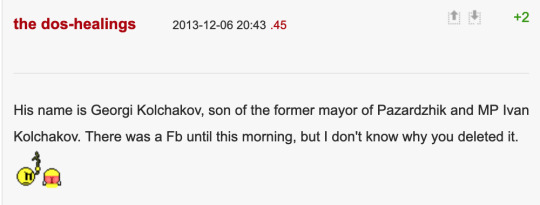
Sadly, there is no link to his social media and based on the advanced search we cannot determine the man's present profile.
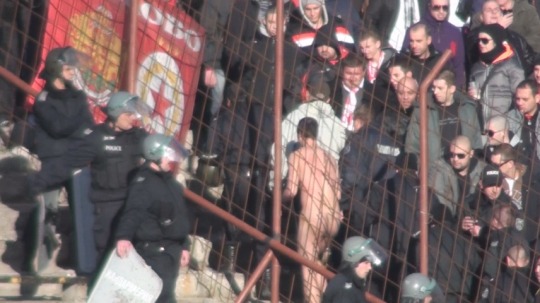
After getting stripped, the naked man has been trapped on the wrong side of the fence and he couldn't climb over the fence to leave the danger zone. After few minutes the police arrived and the man has been escorted out of the stadium. His walk of shame has begun. As he was being walked out with his ass out, the other men were looking at him and his humiliation.
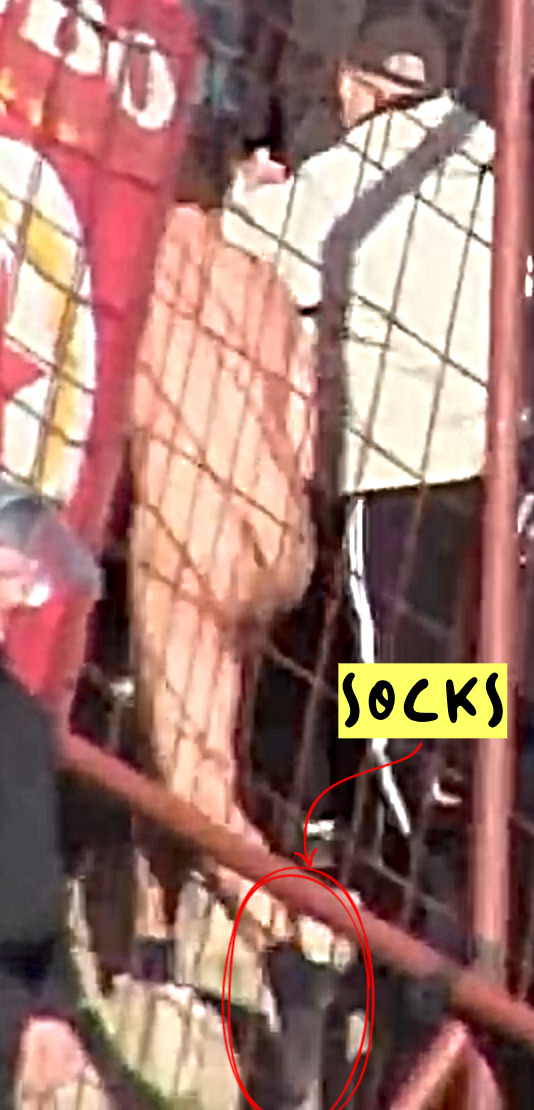
We can notice that the man was wearing only socks. This means not only his clothes were taken away from him but also his shoes. As usual, the man's socks has been left on to make him look even more stupid and to enhance his humiliation.

After reaching the exit of the stadium, it turned out the gate is closed and the police cannot get the naked man out of the site.
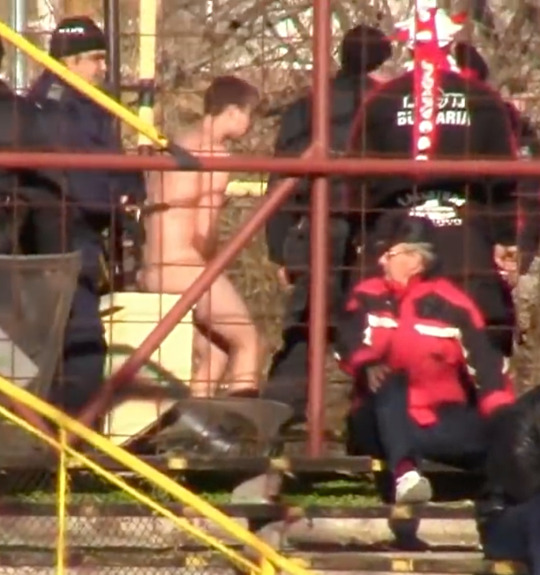
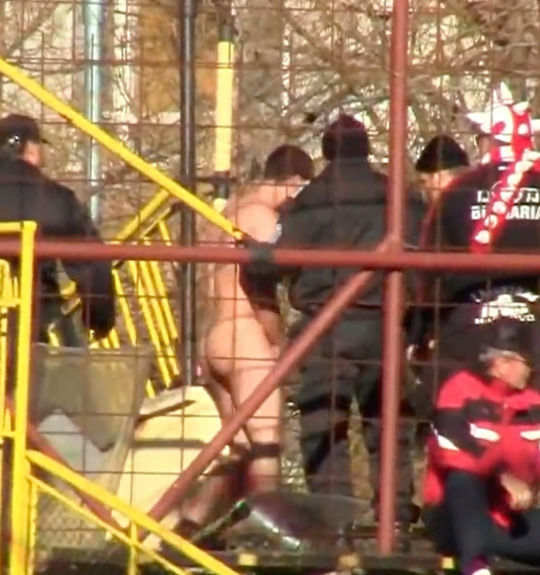
The police officers told him to walk back and sit down with his bare ass and wait until they open the gate. All this time his rivals were observing him and seeing him naked.
The Clothed Men (CM)

The men with clothes were techinically the whole stadium, including the naked man's rivals, stewarts and police officers. We estimated there could had been thousands of them. The one that stood nearest were probably the ones who had stripped the man naked.
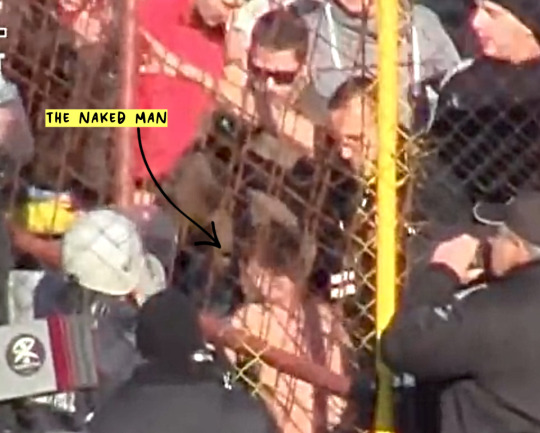

You can notice that some of the men are smiling. Some of them are laughing out loud. And some of them are yelling. The naked man was surrounded by his rival and had to suffer from being mocked and laughed at. One man was spotted telling the naked man to leave the stadium, pointing his arm and finger upstairs, indicating he could had been saying something like "Walk out, get the fuck out of here".
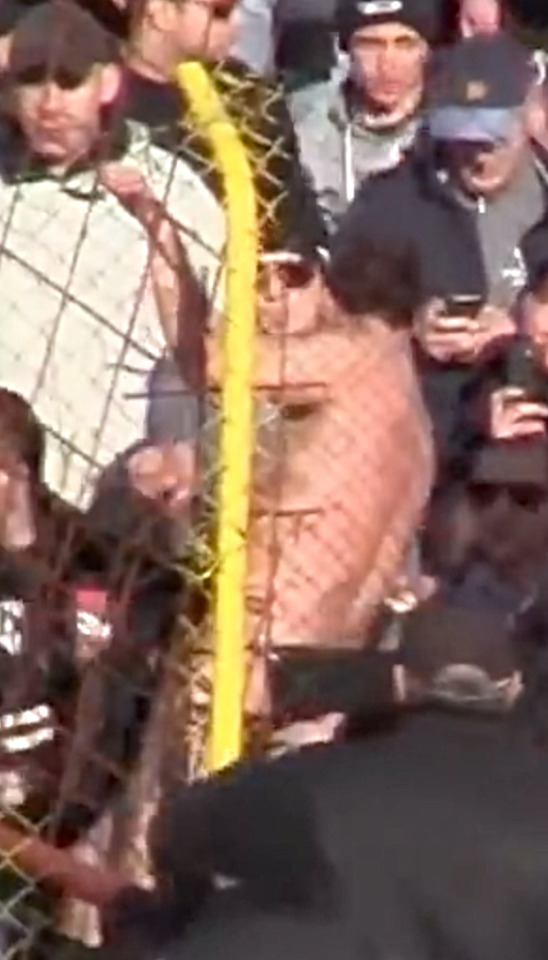
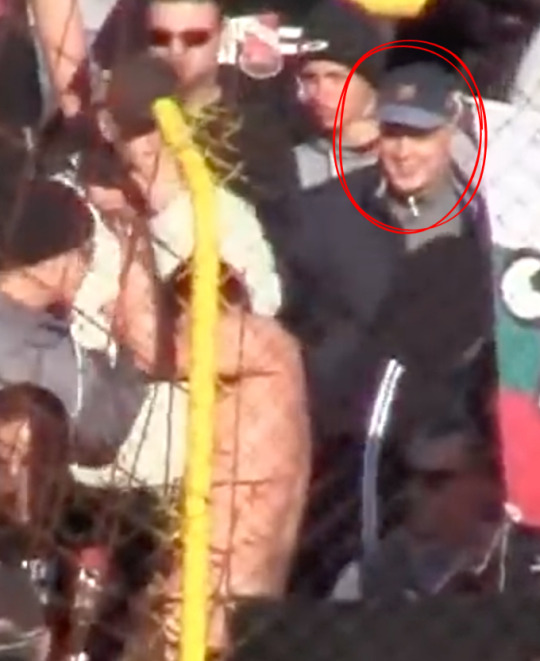
Right after the man was stripped, he was trying to leave the rival's sector by climbing on the fence. Because of being naked and without shoes, he couldn't climb on causing other man to laugh at him. We could spot one guy that clearly is smiling while looking at the naked man.

It is estimated that the man spent about 6-7 minutes naked on the stadium, among hundreds of clothed men that were his rivals. He was walked back and forth by the police in search of the exit. All this time he was covering his dick but his ass was on the display for all that time. And it will remain to be seen on the internet forever.
90 notes
·
View notes
Text
Bulgarian provinces's names
Current plan is to have 19 male provinces and 9 female. They are mostly based on the gender of the names of the provinces.
Male: Vidin, Pleven, Lovech, Razgrad, Shumen, Dobrich, Burgas, Sliven, Yambol, Plovdiv, Smolyan, Pazardzhik, Pernik, Kyustendil, Gabrovo, Haskovo, Blagoevgrad, Sofia city, Sofia province
Female: Montana, Vraca, Silistra, Varna, Stara Zagora, Veliko Tarnovo, Ruse, Targovishte, Kardzhali
I tried to make more provinces female by adding some in neuter gender though I am not too sure how much they fit. But we'll see. Regardless, I will need a lot of names. I have a some sort of a list of male names, but I'm not too confident in how much I love it. I will later add some female too. I just need some more diversity, because I feel like some of the names are very close.
They are: Alexiy, Bozhidar, Blagoy, Valeri, Vasil, Veselin, Viktor, Vladimir, Daniel, Dobromir, Dragan, Krasimir, Kristiyan, Lyubomir, Lyudmil, Mikhail, Pavel, Plamen, Radostin, Svetlozar, Simeon
Viktor is saved for Sofia city. If you have any other names or think a certain name fits a specific province, please help.
#aph bulgaria#hetalia bulgaria#hws bulgaria#bulgaria#hetalia#hws#aphbulgaria#aph#nbeingthing_bulgaria#nbeingthing
4 notes
·
View notes
Text
Authorities are working on ��all possible versions” regarding the murder in broad daylight of influential Bulgarian business figure Alexei Petrov while police are still researching the crime scene, media reported on Thursday.
“The version that the murder was ordered by people close to him has not been ruled out,” reported bTV channel.
In the meantime, MP Atanas Atanasov demanded a high-level meeting on national security following the murder.
On Wednesday, representatives of the Prosecution and the Ministry of Interior gave a briefing where they said that witnesses are being questioned but without giving any further update on the possible motive or type of weapon used.
Petrov was shot dead on Wednesday along with an as yet unidentified woman who is now confirmed to have survived the attack. They were in the presence of three bodyguards, walking around a forest route in Sofia’s Vitosha mountain, near Dragalevski neighbourhood where Petrov lived.
Bulgarian National Television reported on Thursday that Petrov was not expecting any danger and his security was behind him.
This is the latest killing of an influential figure with alleged criminal ties from the same generation. On May 25, Krassimir Kanev “Kyro”, along with three other people, was shot dead in his home in Cape Town, South Africa.
Some experts see a possible tie between the killings. Politicians and commentators have also adopted the phrase that Bulgaria is “returning to the 1990s” because of the increased attacks on organised crime figures, symptomatic of internal conflicts.
“The mobster years have never gone away,” commented Democratic Bulgaria MP Ivaylo Mirchev on Wednesday.
“Key figures who knew and remembered quite a lot are now going away,” investigative journalist Miroluba Benatova told Bulgarian National Radio on Thursday, adding: “Everyone is surprised by this murder. Such turnouts are not to be expected, especially when it concerns such an influential figure who has been through everything.”
Petrov, sometimes nicknamed “The Tractor” for his imposing character, was born in 1962. He graduated from the police academy in Pazardzhik in 1981 and worked as part of Bulgaria’s anti-terorrism unit during the last decade of the Communist regime as well as in the structures of the repressive state security apparatus, including as an undercover agent.
In the early 1990s, some members of the former police entered the private sector through insurance and security firms. Petrov was part of this trend. These firms are now often associated with organised crime, political influence and assassinations of other influential figures in the late-1890s and early-2000s.
There were previous assassination attempts against Petrov in 1998, 2002 and 2015, all ending without conclusive investigations.
“After the turbulent 1990s, Petrov underwent a metamorphosis, typical of many similar individuals in Eastern Europe in that transitional era. He began to gradually make his business more transparent, as well as entering official relations with state institutions,” wrote Capital Weekly newspaper.
It noted that Petrov was one of the supporters of future Sofia mayor, three-time Prime Minister and GERB party leader Boyko Borissov – who also developed businesses in security, was once a bodyguard to Communist leader Todor Zhivkov in the 1990s and in 1998 had shares in a firm along with Petrov.
Despite this connection, in 2010, Petrov was briefly arrested as part of a raid against an organised crime group, and in 2011 was investigated for bribery, corruption and extorsion among other charges. He denied wrongdoing, was later cleared and successfully counter-sued the state for 21 million euro in damages.
On February 17, in a TV interview, Borissov said he and Petrov “we were always opponents, although not enemies” and credited him with preventing a terrorist attack in Sofia in the mid-1980s without providing further details.
In 2011 Petrov founded the major insurance company Lev Ins.
Petrov was also a lecturer on national and cyber security at Sofia’s University of National and World Economy as well as at Plovdiv University. His rich biography includes positions such being the President of Bulgaria’s karate association.
In his most recent interviews, Petrov was critical of the current politics of GERB and was also in favour of the ousting of Prosecutor General Ivan Geshev, who was a subject of an attack in May.
Borissov has yet to comment on the murder.
Opponents of the current coalition, such as former GERB member and Interior Minister Tsvetan Tsvetanov and recent interim Interior Minister Ivan Demerdzhiev, noted in their first statements that Petrov was instrumental in the creation of the current cabinet, featuring two opposing blocks.
2 notes
·
View notes
Text
More than 20 individuals have been detained across Bulgaria during operations led by the Ministry of Internal Affairs targeting vote buying. This information was confirmed by the Ministry.
In Pazardzhik and Panagyurishte, authorities conducted a search at a residence in Strelcha, where a 68-year-old woman resides. The investigation was initiated following a tip-off regarding the provision of property benefits in exchange for voting rights. During the search, officials seized numerous notebooks and flash drives containing personal data related to the local population. The woman was subsequently detained for 24 hours under police measures.
As part of the ongoing operation, a thorough inspection of various pawnshops, credit institutions, and commercial establishments was conducted in the Razgrad region. In the village of Osenets alone, employees from the "Combating Economic Crime" sector inspected three quick loan offices, one pawn shop, and three commercial entities.
Additionally, in the Dobrich region, the Ministry of Internal Affairs reported the detention of nine individuals during the police actions, with a total of 326 vehicles checked in the process.
In Varna, 15 arrests were made during the crackdown on vote buying, leading to three pre-trial proceedings being initiated. To date, 11 commercial establishments have been inspected.
Furthermore, four pre-trial proceedings have been launched in Tvarditsa, Sliven district, three of which relate to the possession of firewood without the necessary documentation of origin. This operation also involved checks on commercial establishments and pawnshops.
1 note
·
View note
Photo

The Underground Resistance Movements in Bulgaria
Overview of Resistance Organizations
During the oppressive years of the communist regime in Bulgaria, many underground organizations formed to resist the government’s actions, particularly against land appropriation and political repression. These groups, composed of brave individuals from various backgrounds, organized armed resistance and sought to protect their rights and freedoms.
Union of Free Warriors
The “Union of Free Warriors” was established in the Pazardzhik region in 1949. This organization was created to oppose the forced land appropriations that the government was carrying out. With about 280 members, they formed an armed Goriyani detachment to fight against these injustices.
Underground Patriotic Organization
In the Trun region, the “Underground Patriotic Organization” was set up in 1949. Led by Nikola Yordanov, also known as Gudzho, this group initially had around 80 members. Under his leadership, the detachment grew to 450 members and organized itself into 30 fighting groups, covering 40 villages in the Breznik region and 10 villages in Trun Istanbul Day Tour.
Bulgarian Resistance Movement The “Bulgarian Resistance Movement” was formed in the autumn of 1950 under the leadership of Blagoy Zlatanski, who would later be executed by a firing squad in 1953. This organization had about 200 members and maintained close ties with the Goriyani movement in the Dupnitsa region.
Orange Party
The “Orange Party” was another underground group created in the Yambol district in 1950, formed by poor and middle-class peasants. They successfully set up structures in 21 villages, showing the widespread resistance against the regime.
Agrarian Centers and Youth Organizations
In the autumn of 1950, the “District Agrarian Center No. 1” was established in the Rousse region. Additionally, an Underground Organization of Samokov was formed around the same time but was discovered by the government in late 1951, leading to the execution of its leaders.
The “Committee for Resistance”, led by Kosta Deykov, also emerged in the Sliven region in 1950 and created a Goriyani detachment that spread across 19 villages in the Sliven, Kazanluk, and Nova Zagora districts.
Youth Activism
Youth organizations were particularly active during this time. The Agrarian Youth Union was created in Sofia in 1950 to fight against the regime. The “Call for Freedom” was another youth group founded in the Ihtiman region in the summer of 1950, led by Slavcho Zashev, who was sentenced to death in 1952.
Additional Organizations
Several other underground organizations were formed during this period, including:
“Partisan Students”, a group of expelled students in Sofia in 1951. “I Am Bulgarian”, created in the Plovdiv region in 1951. “The Goriyani Bulgarian Resistance Movement”, established on April 15, 1951, in Plovdiv. This group focused on training armed resistance units and set up four Goriyani detachments in various districts.
These underground organizations played a significant role in the resistance against the communist regime in Bulgaria. Despite facing harsh repression, their members showed immense courage and dedication in their fight for freedom and justice. Each group, from the Union of Free Warriors to the Goriyani Bulgarian Resistance Movement, contributed to the broader struggle for democracy and human rights in Bulgaria.
0 notes
Photo

The Underground Resistance Movements in Bulgaria
Overview of Resistance Organizations
During the oppressive years of the communist regime in Bulgaria, many underground organizations formed to resist the government’s actions, particularly against land appropriation and political repression. These groups, composed of brave individuals from various backgrounds, organized armed resistance and sought to protect their rights and freedoms.
Union of Free Warriors
The “Union of Free Warriors” was established in the Pazardzhik region in 1949. This organization was created to oppose the forced land appropriations that the government was carrying out. With about 280 members, they formed an armed Goriyani detachment to fight against these injustices.
Underground Patriotic Organization
In the Trun region, the “Underground Patriotic Organization” was set up in 1949. Led by Nikola Yordanov, also known as Gudzho, this group initially had around 80 members. Under his leadership, the detachment grew to 450 members and organized itself into 30 fighting groups, covering 40 villages in the Breznik region and 10 villages in Trun Istanbul Day Tour.
Bulgarian Resistance Movement The “Bulgarian Resistance Movement” was formed in the autumn of 1950 under the leadership of Blagoy Zlatanski, who would later be executed by a firing squad in 1953. This organization had about 200 members and maintained close ties with the Goriyani movement in the Dupnitsa region.
Orange Party
The “Orange Party” was another underground group created in the Yambol district in 1950, formed by poor and middle-class peasants. They successfully set up structures in 21 villages, showing the widespread resistance against the regime.
Agrarian Centers and Youth Organizations
In the autumn of 1950, the “District Agrarian Center No. 1” was established in the Rousse region. Additionally, an Underground Organization of Samokov was formed around the same time but was discovered by the government in late 1951, leading to the execution of its leaders.
The “Committee for Resistance”, led by Kosta Deykov, also emerged in the Sliven region in 1950 and created a Goriyani detachment that spread across 19 villages in the Sliven, Kazanluk, and Nova Zagora districts.
Youth Activism
Youth organizations were particularly active during this time. The Agrarian Youth Union was created in Sofia in 1950 to fight against the regime. The “Call for Freedom” was another youth group founded in the Ihtiman region in the summer of 1950, led by Slavcho Zashev, who was sentenced to death in 1952.
Additional Organizations
Several other underground organizations were formed during this period, including:
“Partisan Students”, a group of expelled students in Sofia in 1951. “I Am Bulgarian”, created in the Plovdiv region in 1951. “The Goriyani Bulgarian Resistance Movement”, established on April 15, 1951, in Plovdiv. This group focused on training armed resistance units and set up four Goriyani detachments in various districts.
These underground organizations played a significant role in the resistance against the communist regime in Bulgaria. Despite facing harsh repression, their members showed immense courage and dedication in their fight for freedom and justice. Each group, from the Union of Free Warriors to the Goriyani Bulgarian Resistance Movement, contributed to the broader struggle for democracy and human rights in Bulgaria.
0 notes
Photo

The Underground Resistance Movements in Bulgaria
Overview of Resistance Organizations
During the oppressive years of the communist regime in Bulgaria, many underground organizations formed to resist the government’s actions, particularly against land appropriation and political repression. These groups, composed of brave individuals from various backgrounds, organized armed resistance and sought to protect their rights and freedoms.
Union of Free Warriors
The “Union of Free Warriors” was established in the Pazardzhik region in 1949. This organization was created to oppose the forced land appropriations that the government was carrying out. With about 280 members, they formed an armed Goriyani detachment to fight against these injustices.
Underground Patriotic Organization
In the Trun region, the “Underground Patriotic Organization” was set up in 1949. Led by Nikola Yordanov, also known as Gudzho, this group initially had around 80 members. Under his leadership, the detachment grew to 450 members and organized itself into 30 fighting groups, covering 40 villages in the Breznik region and 10 villages in Trun Istanbul Day Tour.
Bulgarian Resistance Movement The “Bulgarian Resistance Movement” was formed in the autumn of 1950 under the leadership of Blagoy Zlatanski, who would later be executed by a firing squad in 1953. This organization had about 200 members and maintained close ties with the Goriyani movement in the Dupnitsa region.
Orange Party
The “Orange Party” was another underground group created in the Yambol district in 1950, formed by poor and middle-class peasants. They successfully set up structures in 21 villages, showing the widespread resistance against the regime.
Agrarian Centers and Youth Organizations
In the autumn of 1950, the “District Agrarian Center No. 1” was established in the Rousse region. Additionally, an Underground Organization of Samokov was formed around the same time but was discovered by the government in late 1951, leading to the execution of its leaders.
The “Committee for Resistance”, led by Kosta Deykov, also emerged in the Sliven region in 1950 and created a Goriyani detachment that spread across 19 villages in the Sliven, Kazanluk, and Nova Zagora districts.
Youth Activism
Youth organizations were particularly active during this time. The Agrarian Youth Union was created in Sofia in 1950 to fight against the regime. The “Call for Freedom” was another youth group founded in the Ihtiman region in the summer of 1950, led by Slavcho Zashev, who was sentenced to death in 1952.
Additional Organizations
Several other underground organizations were formed during this period, including:
“Partisan Students”, a group of expelled students in Sofia in 1951. “I Am Bulgarian”, created in the Plovdiv region in 1951. “The Goriyani Bulgarian Resistance Movement”, established on April 15, 1951, in Plovdiv. This group focused on training armed resistance units and set up four Goriyani detachments in various districts.
These underground organizations played a significant role in the resistance against the communist regime in Bulgaria. Despite facing harsh repression, their members showed immense courage and dedication in their fight for freedom and justice. Each group, from the Union of Free Warriors to the Goriyani Bulgarian Resistance Movement, contributed to the broader struggle for democracy and human rights in Bulgaria.
0 notes
Photo

The Underground Resistance Movements in Bulgaria
Overview of Resistance Organizations
During the oppressive years of the communist regime in Bulgaria, many underground organizations formed to resist the government’s actions, particularly against land appropriation and political repression. These groups, composed of brave individuals from various backgrounds, organized armed resistance and sought to protect their rights and freedoms.
Union of Free Warriors
The “Union of Free Warriors” was established in the Pazardzhik region in 1949. This organization was created to oppose the forced land appropriations that the government was carrying out. With about 280 members, they formed an armed Goriyani detachment to fight against these injustices.
Underground Patriotic Organization
In the Trun region, the “Underground Patriotic Organization” was set up in 1949. Led by Nikola Yordanov, also known as Gudzho, this group initially had around 80 members. Under his leadership, the detachment grew to 450 members and organized itself into 30 fighting groups, covering 40 villages in the Breznik region and 10 villages in Trun Istanbul Day Tour.
Bulgarian Resistance Movement The “Bulgarian Resistance Movement” was formed in the autumn of 1950 under the leadership of Blagoy Zlatanski, who would later be executed by a firing squad in 1953. This organization had about 200 members and maintained close ties with the Goriyani movement in the Dupnitsa region.
Orange Party
The “Orange Party” was another underground group created in the Yambol district in 1950, formed by poor and middle-class peasants. They successfully set up structures in 21 villages, showing the widespread resistance against the regime.
Agrarian Centers and Youth Organizations
In the autumn of 1950, the “District Agrarian Center No. 1” was established in the Rousse region. Additionally, an Underground Organization of Samokov was formed around the same time but was discovered by the government in late 1951, leading to the execution of its leaders.
The “Committee for Resistance”, led by Kosta Deykov, also emerged in the Sliven region in 1950 and created a Goriyani detachment that spread across 19 villages in the Sliven, Kazanluk, and Nova Zagora districts.
Youth Activism
Youth organizations were particularly active during this time. The Agrarian Youth Union was created in Sofia in 1950 to fight against the regime. The “Call for Freedom” was another youth group founded in the Ihtiman region in the summer of 1950, led by Slavcho Zashev, who was sentenced to death in 1952.
Additional Organizations
Several other underground organizations were formed during this period, including:
“Partisan Students”, a group of expelled students in Sofia in 1951. “I Am Bulgarian”, created in the Plovdiv region in 1951. “The Goriyani Bulgarian Resistance Movement”, established on April 15, 1951, in Plovdiv. This group focused on training armed resistance units and set up four Goriyani detachments in various districts.
These underground organizations played a significant role in the resistance against the communist regime in Bulgaria. Despite facing harsh repression, their members showed immense courage and dedication in their fight for freedom and justice. Each group, from the Union of Free Warriors to the Goriyani Bulgarian Resistance Movement, contributed to the broader struggle for democracy and human rights in Bulgaria.
0 notes
Photo

The Underground Resistance Movements in Bulgaria
Overview of Resistance Organizations
During the oppressive years of the communist regime in Bulgaria, many underground organizations formed to resist the government’s actions, particularly against land appropriation and political repression. These groups, composed of brave individuals from various backgrounds, organized armed resistance and sought to protect their rights and freedoms.
Union of Free Warriors
The “Union of Free Warriors” was established in the Pazardzhik region in 1949. This organization was created to oppose the forced land appropriations that the government was carrying out. With about 280 members, they formed an armed Goriyani detachment to fight against these injustices.
Underground Patriotic Organization
In the Trun region, the “Underground Patriotic Organization” was set up in 1949. Led by Nikola Yordanov, also known as Gudzho, this group initially had around 80 members. Under his leadership, the detachment grew to 450 members and organized itself into 30 fighting groups, covering 40 villages in the Breznik region and 10 villages in Trun Istanbul Day Tour.
Bulgarian Resistance Movement The “Bulgarian Resistance Movement” was formed in the autumn of 1950 under the leadership of Blagoy Zlatanski, who would later be executed by a firing squad in 1953. This organization had about 200 members and maintained close ties with the Goriyani movement in the Dupnitsa region.
Orange Party
The “Orange Party” was another underground group created in the Yambol district in 1950, formed by poor and middle-class peasants. They successfully set up structures in 21 villages, showing the widespread resistance against the regime.
Agrarian Centers and Youth Organizations
In the autumn of 1950, the “District Agrarian Center No. 1” was established in the Rousse region. Additionally, an Underground Organization of Samokov was formed around the same time but was discovered by the government in late 1951, leading to the execution of its leaders.
The “Committee for Resistance”, led by Kosta Deykov, also emerged in the Sliven region in 1950 and created a Goriyani detachment that spread across 19 villages in the Sliven, Kazanluk, and Nova Zagora districts.
Youth Activism
Youth organizations were particularly active during this time. The Agrarian Youth Union was created in Sofia in 1950 to fight against the regime. The “Call for Freedom” was another youth group founded in the Ihtiman region in the summer of 1950, led by Slavcho Zashev, who was sentenced to death in 1952.
Additional Organizations
Several other underground organizations were formed during this period, including:
“Partisan Students”, a group of expelled students in Sofia in 1951. “I Am Bulgarian”, created in the Plovdiv region in 1951. “The Goriyani Bulgarian Resistance Movement”, established on April 15, 1951, in Plovdiv. This group focused on training armed resistance units and set up four Goriyani detachments in various districts.
These underground organizations played a significant role in the resistance against the communist regime in Bulgaria. Despite facing harsh repression, their members showed immense courage and dedication in their fight for freedom and justice. Each group, from the Union of Free Warriors to the Goriyani Bulgarian Resistance Movement, contributed to the broader struggle for democracy and human rights in Bulgaria.
0 notes
Photo

The Underground Resistance Movements in Bulgaria
Overview of Resistance Organizations
During the oppressive years of the communist regime in Bulgaria, many underground organizations formed to resist the government’s actions, particularly against land appropriation and political repression. These groups, composed of brave individuals from various backgrounds, organized armed resistance and sought to protect their rights and freedoms.
Union of Free Warriors
The “Union of Free Warriors” was established in the Pazardzhik region in 1949. This organization was created to oppose the forced land appropriations that the government was carrying out. With about 280 members, they formed an armed Goriyani detachment to fight against these injustices.
Underground Patriotic Organization
In the Trun region, the “Underground Patriotic Organization” was set up in 1949. Led by Nikola Yordanov, also known as Gudzho, this group initially had around 80 members. Under his leadership, the detachment grew to 450 members and organized itself into 30 fighting groups, covering 40 villages in the Breznik region and 10 villages in Trun Istanbul Day Tour.
Bulgarian Resistance Movement The “Bulgarian Resistance Movement” was formed in the autumn of 1950 under the leadership of Blagoy Zlatanski, who would later be executed by a firing squad in 1953. This organization had about 200 members and maintained close ties with the Goriyani movement in the Dupnitsa region.
Orange Party
The “Orange Party” was another underground group created in the Yambol district in 1950, formed by poor and middle-class peasants. They successfully set up structures in 21 villages, showing the widespread resistance against the regime.
Agrarian Centers and Youth Organizations
In the autumn of 1950, the “District Agrarian Center No. 1” was established in the Rousse region. Additionally, an Underground Organization of Samokov was formed around the same time but was discovered by the government in late 1951, leading to the execution of its leaders.
The “Committee for Resistance”, led by Kosta Deykov, also emerged in the Sliven region in 1950 and created a Goriyani detachment that spread across 19 villages in the Sliven, Kazanluk, and Nova Zagora districts.
Youth Activism
Youth organizations were particularly active during this time. The Agrarian Youth Union was created in Sofia in 1950 to fight against the regime. The “Call for Freedom” was another youth group founded in the Ihtiman region in the summer of 1950, led by Slavcho Zashev, who was sentenced to death in 1952.
Additional Organizations
Several other underground organizations were formed during this period, including:
“Partisan Students”, a group of expelled students in Sofia in 1951. “I Am Bulgarian”, created in the Plovdiv region in 1951. “The Goriyani Bulgarian Resistance Movement”, established on April 15, 1951, in Plovdiv. This group focused on training armed resistance units and set up four Goriyani detachments in various districts.
These underground organizations played a significant role in the resistance against the communist regime in Bulgaria. Despite facing harsh repression, their members showed immense courage and dedication in their fight for freedom and justice. Each group, from the Union of Free Warriors to the Goriyani Bulgarian Resistance Movement, contributed to the broader struggle for democracy and human rights in Bulgaria.
0 notes
Photo

The Underground Resistance Movements in Bulgaria
Overview of Resistance Organizations
During the oppressive years of the communist regime in Bulgaria, many underground organizations formed to resist the government’s actions, particularly against land appropriation and political repression. These groups, composed of brave individuals from various backgrounds, organized armed resistance and sought to protect their rights and freedoms.
Union of Free Warriors
The “Union of Free Warriors” was established in the Pazardzhik region in 1949. This organization was created to oppose the forced land appropriations that the government was carrying out. With about 280 members, they formed an armed Goriyani detachment to fight against these injustices.
Underground Patriotic Organization
In the Trun region, the “Underground Patriotic Organization” was set up in 1949. Led by Nikola Yordanov, also known as Gudzho, this group initially had around 80 members. Under his leadership, the detachment grew to 450 members and organized itself into 30 fighting groups, covering 40 villages in the Breznik region and 10 villages in Trun Istanbul Day Tour.
Bulgarian Resistance Movement The “Bulgarian Resistance Movement” was formed in the autumn of 1950 under the leadership of Blagoy Zlatanski, who would later be executed by a firing squad in 1953. This organization had about 200 members and maintained close ties with the Goriyani movement in the Dupnitsa region.
Orange Party
The “Orange Party” was another underground group created in the Yambol district in 1950, formed by poor and middle-class peasants. They successfully set up structures in 21 villages, showing the widespread resistance against the regime.
Agrarian Centers and Youth Organizations
In the autumn of 1950, the “District Agrarian Center No. 1” was established in the Rousse region. Additionally, an Underground Organization of Samokov was formed around the same time but was discovered by the government in late 1951, leading to the execution of its leaders.
The “Committee for Resistance”, led by Kosta Deykov, also emerged in the Sliven region in 1950 and created a Goriyani detachment that spread across 19 villages in the Sliven, Kazanluk, and Nova Zagora districts.
Youth Activism
Youth organizations were particularly active during this time. The Agrarian Youth Union was created in Sofia in 1950 to fight against the regime. The “Call for Freedom” was another youth group founded in the Ihtiman region in the summer of 1950, led by Slavcho Zashev, who was sentenced to death in 1952.
Additional Organizations
Several other underground organizations were formed during this period, including:
“Partisan Students”, a group of expelled students in Sofia in 1951. “I Am Bulgarian”, created in the Plovdiv region in 1951. “The Goriyani Bulgarian Resistance Movement”, established on April 15, 1951, in Plovdiv. This group focused on training armed resistance units and set up four Goriyani detachments in various districts.
These underground organizations played a significant role in the resistance against the communist regime in Bulgaria. Despite facing harsh repression, their members showed immense courage and dedication in their fight for freedom and justice. Each group, from the Union of Free Warriors to the Goriyani Bulgarian Resistance Movement, contributed to the broader struggle for democracy and human rights in Bulgaria.
0 notes
Photo

The Underground Resistance Movements in Bulgaria
Overview of Resistance Organizations
During the oppressive years of the communist regime in Bulgaria, many underground organizations formed to resist the government’s actions, particularly against land appropriation and political repression. These groups, composed of brave individuals from various backgrounds, organized armed resistance and sought to protect their rights and freedoms.
Union of Free Warriors
The “Union of Free Warriors” was established in the Pazardzhik region in 1949. This organization was created to oppose the forced land appropriations that the government was carrying out. With about 280 members, they formed an armed Goriyani detachment to fight against these injustices.
Underground Patriotic Organization
In the Trun region, the “Underground Patriotic Organization” was set up in 1949. Led by Nikola Yordanov, also known as Gudzho, this group initially had around 80 members. Under his leadership, the detachment grew to 450 members and organized itself into 30 fighting groups, covering 40 villages in the Breznik region and 10 villages in Trun Istanbul Day Tour.
Bulgarian Resistance Movement The “Bulgarian Resistance Movement” was formed in the autumn of 1950 under the leadership of Blagoy Zlatanski, who would later be executed by a firing squad in 1953. This organization had about 200 members and maintained close ties with the Goriyani movement in the Dupnitsa region.
Orange Party
The “Orange Party” was another underground group created in the Yambol district in 1950, formed by poor and middle-class peasants. They successfully set up structures in 21 villages, showing the widespread resistance against the regime.
Agrarian Centers and Youth Organizations
In the autumn of 1950, the “District Agrarian Center No. 1” was established in the Rousse region. Additionally, an Underground Organization of Samokov was formed around the same time but was discovered by the government in late 1951, leading to the execution of its leaders.
The “Committee for Resistance”, led by Kosta Deykov, also emerged in the Sliven region in 1950 and created a Goriyani detachment that spread across 19 villages in the Sliven, Kazanluk, and Nova Zagora districts.
Youth Activism
Youth organizations were particularly active during this time. The Agrarian Youth Union was created in Sofia in 1950 to fight against the regime. The “Call for Freedom” was another youth group founded in the Ihtiman region in the summer of 1950, led by Slavcho Zashev, who was sentenced to death in 1952.
Additional Organizations
Several other underground organizations were formed during this period, including:
“Partisan Students”, a group of expelled students in Sofia in 1951. “I Am Bulgarian”, created in the Plovdiv region in 1951. “The Goriyani Bulgarian Resistance Movement”, established on April 15, 1951, in Plovdiv. This group focused on training armed resistance units and set up four Goriyani detachments in various districts.
These underground organizations played a significant role in the resistance against the communist regime in Bulgaria. Despite facing harsh repression, their members showed immense courage and dedication in their fight for freedom and justice. Each group, from the Union of Free Warriors to the Goriyani Bulgarian Resistance Movement, contributed to the broader struggle for democracy and human rights in Bulgaria.
0 notes
Link
0 notes
Text
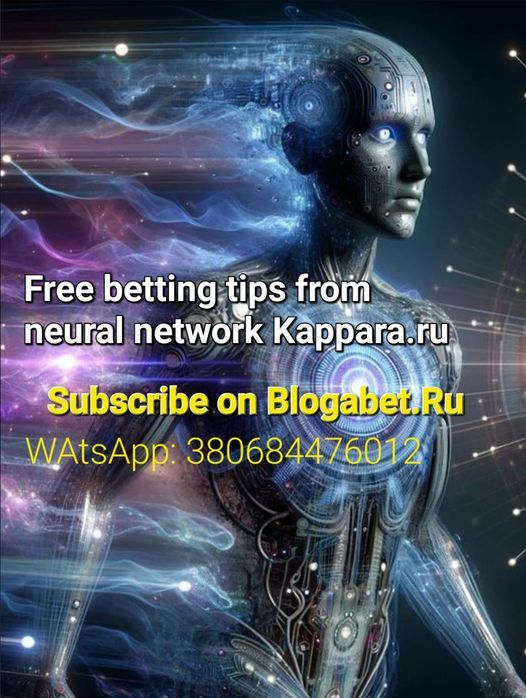
13.05.24 15:30 Колос Ковалевка - ЛНЗ-Лебедин 1-1 1X 1.32 13.05.24 17:45 Этыр - Локомотив София 2-1 1х и ТБ(1.5) Да 1.62 13.05.24 18:00 Заря - Верес 1-1 Ф2(+1.5) 1.31, удаление да 13.05.24 18:00 ЖК Заря - ЖК Верес 2-3 ЖК Верес ИТБ2(1.5) 1.32 13.05.24 19:30 Лечче - Удинезе 1-1 ТБ(1.5) 1.42 13.05.24 20:15 Ботев Враца - Хебыр Пазарджик 2-1 ТБ(1.5) 1.33 13.05.24 21:00 Бреда - Рода 1-1 Обе забьют: Да 1.55 13.05.24 21:30 Брюгге - Сент-Жиллуаз 1-0 Ф1(0) 1.56 13.05.24 21:45 Фиорентина - Монца 1-0 1х и ТМ(4.5) Да 1.4 13.05.24 22:00 Барселона - Реал Сосьедад 1-1 Ф2(+1.5) 1.39 13.05.24 22:00 Астон Вилла - Ливерпуль 2-2 Ф1(+1.5) 1.46 13.05.24 22:15 Лейрия - Академику Визеу 2-1 ТБ(2) 1.53 14.05.24 02:00 Сан-Паулу - Флуминенсе 2-1 Сан-Паулу ИТБ1(1) 1.36 14.05.24 03:00 Унион де СФ - Банфилд 1-0 1X 1.33 Статистика прогнозов тут : https://t.me/KapparaLive/1720 Мой канал в телеге : https://t.me/kappara_ru (здесь прогнозы по ходу дня) Список Букмекерских сайтов : http://hubu.ru/sportwager Watsapp группа пис��ть : +380684476012 Зеркало прогнозов на сайте http://kappara.online (english tips) Сайт http://kappara.ru обмениваюсь ссылками , взаимопиар, заказ рекламных статей с вашими ссылками 13.05.24 15:30 Kolos Kovalivka - LNZ-Lebedyn 1X 1.32 13.05.24 17:45 PFC Etar Veliko Tarnovo - PFC Lokomotiv Sofia Not to lose and Total Over(1.5) - PFC Lokomotiv Sofia : Yes 1.62 13.05.24 18:00 Zorya - Veres 2T Handicap(+1.5) 1.31 13.05.24 18:00 Yellow cards Zorya - Yellow cards Veres Yellow cards Veres 2T Individual Total Over(1.5) 1.32 13.05.24 19:30 Lecce - Udinese Total Over(1.5) 1.42 13.05.24 20:15 PFK Botev Vratsa - Hebar Pazardzhik Total Over(1.5) 1.33 13.05.24 21:00 NAC Breda - Roda Both teams to score: Yes 1.55 13.05.24 21:30 Club Brugge - Union St. Gilloise 1T Handicap(0) 1.56 13.05.24 21:45 Fiorentina - Monza Not to lose and Total Under(4.5) - Fiorentina : Yes 1.4 13.05.24 22:00 Barcelona - Real Sociedad 2T Handicap(+1.5) 1.39 13.05.24 22:00 Aston Villa - Liverpool 1T Handicap(+1.5) 1.46 13.05.24 22:15 Uniao Leiria - Academico Viseu Total Over(2) 1.53 14.05.24 02:00 Sao Paulo - Fluminense Sao Paulo 1T Individual Total Over(1) 1.36 14.05.24 03:00 Union de SF - Banfield 1X 1.33 Stats of this predictions here : : https://t.me/KapparaLive/1720 My channel : https://t.me/KapparaVip Bookmaker top30 : http://hubu.ru/sportwager Watsapp group : +380684476012 My tips here : http://kappara.online Site http://kappara.ru link exgange , paid articles , partners program write to watsapp
0 notes
Text
¿Cuál es la dirección y horario de atención de FK Hebar Pazardzhik?
🎰🎲✨ ¡Obtén 500 euros y 200 giros gratis para jugar juegos de casino con solo un clic! ✨🎲🎰
¿Cuál es la dirección y horario de atención de FK Hebar Pazardzhik?
Dirección FK Hebar Pazardzhik
La Dirección FK Hebar Pazardzhik es un club de fútbol búlgaro con sede en Pazardzhik, una ciudad histórica situada en el suroeste de Bulgaria. Fundado en 1921, el club ha sido un pilar en el panorama del fútbol búlgaro durante décadas.
El FK Hebar Pazardzhik ha tenido altibajos a lo largo de su historia, pero ha logrado construir una base de seguidores devotos que lo apoyan en cada partido. El equipo ha competido en varias divisiones del fútbol búlgaro y ha dejado su huella en el deporte nacional.
El estadio del FK Hebar Pazardzhik es el Estadio Hebar, que cuenta con una capacidad para albergar a miles de espectadores. Los partidos en casa son un espectáculo imperdible, ya que la afición del FK Hebar Pazardzhik crea un ambiente vibrante y apasionado en cada encuentro.
Además de sus logros en el campo de juego, el FK Hebar Pazardzhik también ha estado involucrado en iniciativas comunitarias y sociales en la región de Pazardzhik. El club ha brindado oportunidades deportivas a la juventud local y ha promovido los valores de trabajo en equipo, dedicación y deportividad.
En resumen, la Dirección FK Hebar Pazardzhik es mucho más que un club de fútbol; es una parte integral de la comunidad de Pazardzhik y un símbolo del espíritu deportivo búlgaro.
Horario atención FK Hebar Pazardzhik
El horario de atención del FK Hebar Pazardzhik es un tema importante para los aficionados y seguidores del equipo de fútbol. Conocer los días y las horas en que el club está disponible para atender a sus seguidores es fundamental para mantener una comunicación efectiva.
Generalmente, el horario de atención del FK Hebar Pazardzhik varía según la temporada y las actividades programadas. Por lo tanto, es recomendable que los seguidores verifiquen los horarios actualizados antes de acudir a las instalaciones del club.
Para obtener información detallada sobre el horario de atención del FK Hebar Pazardzhik, se recomienda visitar su sitio web oficial o sus redes sociales, donde suelen publicar los días y horarios en que el club está disponible para atender consultas, ofrecer información sobre eventos y ventas de entradas, así como brindar atención al cliente.
Además, es importante tener en cuenta que el horario de atención puede cambiar temporalmente debido a eventos especiales, partidos, entrenamientos u otras circunstancias. Por lo tanto, se aconseja a los seguidores estar atentos a cualquier actualización o cambio en el horario de atención del FK Hebar Pazardzhik.
En resumen, estar informado sobre el horario de atención del FK Hebar Pazardzhik es esencial para todos aquellos que desean mantenerse en contacto con el club y estar al tanto de sus actividades y novedades. ¡No olvides verificar los horarios antes de planificar tu visita al FK Hebar Pazardzhik!
Ubicación precisa FK Hebar Pazardzhik
FK Hebar Pazardzhik es un club de fútbol con una ubicación precisa en la ciudad de Pazardzhik, Bulgaria. Fundado en 1919, el club ha sido un pilar en la comunidad local y ha ganado reconocimiento a lo largo de los años por su desempeño en el campo de juego.
El estadio del FK Hebar Pazardzhik es el Estadio Hebar, que se encuentra ubicado en el corazón de la ciudad. Este estadio es el hogar del equipo y es donde juegan sus partidos como locales. Con una capacidad para miles de espectadores, el Estadio Hebar es un lugar emblemático para los aficionados y seguidores del club.
Además de su participación en la liga local, FK Hebar Pazardzhik también ha tenido éxito en competiciones nacionales e internacionales. El club ha demostrado un compromiso con el desarrollo de jóvenes talentos y ha creado un ambiente propicio para el crecimiento y la formación de nuevos futbolistas.
En resumen, la ubicación precisa del FK Hebar Pazardzhik en la ciudad de Pazardzhik ha sido fundamental para su historia y su conexión con la comunidad local. El club ha dejado una huella imborrable en el fútbol búlgaro y sigue siendo una fuente de orgullo para la ciudad y sus habitantes.
Horario de apertura FK Hebar Pazardzhik
El horario de apertura del FK Hebar Pazardzhik es información vital para los aficionados al fútbol y para aquellos que desean visitar el estadio. FK Hebar Pazardzhik, un club de fútbol búlgaro con sede en la ciudad de Pazardzhik, tiene un horario de apertura que varía dependiendo de diversos factores, como los días de partido y los eventos especiales que se lleven a cabo en el estadio.
Por lo general, el estadio del FK Hebar Pazardzhik abre sus puertas unas horas antes del inicio de los partidos programados. Es importante para los aficionados llegar con suficiente antelación para evitar aglomeraciones y asegurarse de encontrar un buen lugar desde donde disfrutar del encuentro.
Para obtener información precisa sobre el horario de apertura de FK Hebar Pazardzhik, se recomienda consultar los canales oficiales del club, como su página web o redes sociales. Allí, los seguidores encontrarán actualizaciones sobre los horarios de apertura, así como cualquier cambio de última hora que pueda surgir.
Además, es importante recordar que el horario de apertura del estadio puede variar en función de factores externos, como el clima o decisiones de última hora por parte de las autoridades pertinentes. Por lo tanto, se aconseja a los aficionados estar atentos a cualquier anuncio oficial del club para evitar inconvenientes.
En resumen, para aquellos que planean asistir a un partido del FK Hebar Pazardzhik, es fundamental conocer el horario de apertura del estadio y llegar con tiempo suficiente para disfrutar de una experiencia sin contratiempos.
Direcciones de FK Hebar Pazardzhik
FK Hebar Pazardzhik es un equipo de fútbol búlgaro con una larga historia y una base de seguidores apasionados. Si estás buscando las direcciones para llegar al estadio de FK Hebar Pazardzhik, estás en el lugar correcto.
El estadio de FK Hebar Pazardzhik se encuentra en la ciudad de Pazardzhik, un importante centro urbano en Bulgaria. La dirección exacta del estadio es Boulevard "Vasil Levski", 4400 Pazardzhik, Bulgaria. La ubicación del estadio en el Boulevard "Vasil Levski" lo hace fácilmente accesible tanto para los residentes locales como para los visitantes que vienen a apoyar al equipo.
Para llegar al estadio de FK Hebar Pazardzhik, puedes utilizar diferentes medios de transporte. Si vienes en coche, puedes seguir las indicaciones viales hacia el Boulevard "Vasil Levski" en Pazardzhik. También puedes optar por utilizar el transporte público, como autobuses o taxis, que te dejarán cerca del estadio.
Una vez que llegues al estadio de FK Hebar Pazardzhik, podrás disfrutar de la emoción y la pasión del fútbol búlgaro en un ambiente único. Los aficionados locales son conocidos por su fervor y su apoyo incondicional al equipo, lo que crea una atmósfera vibrante en cada partido.
En resumen, si deseas asistir a un emocionante partido de fútbol en FK Hebar Pazardzhik, ahora conoces la dirección exacta del estadio y cómo llegar allí. ¡No dudes en vivir la experiencia y apoyar a este emblemático equipo búlgaro en su camino hacia la victoria!
0 notes